Saturday, February 9, 2019
Weekly Indicators for February 4 - 8 at Seeking Alpha
- by New Deal democrat
My Weekly Indicators post is up at Seeking Alpha.
The weekly model is at (slight) variance with the model under which I have gone on “recession watch.” Inevitably we trade noisiness and less completeleness for timeliness.
Friday, February 8, 2019
What does a “Recession Watch” mean?
-by New Deal democrat
On Wednesday I went on “Recession Watch” beginning Q4 of this year.
Yesterday I explained what that means in detail over at Seeking Alpha.
So, what happens after this?
- If the weakness persists and spreads to the short leading indicators, the “watch” turns into a.warning.
- If the weakness abates without spreading into the short leading indicators, the “watch” is lifted.
As always, I will be relentlessly data-driven.
Thursday, February 7, 2019
Recession Watch beginning Q4 2019
- by New Deal democrat
It had to happen someday.
My comprehensive update of the long leading indicators is up at Seeking Alpha.
After almost 10 years of being relentlessly positive, enough of the long leading indicators have turned negative to warrant a “Recession Watch” beginning in the 4th quarter of this year. (And only one day after Bill McBride a/k/a Calculated Risk Pooh-poohed such things, too! But I go where the data takes me.)
A word of caution: this doesn’t mean that a near-term recession is certain, and it doesn’t mean that it is certain to begin in Q4. But it is very much in play.
Wednesday, February 6, 2019
February short leading data starts out decent
- by New Deal democrat
We’ve had two pieces of forward looking data in the last week (in addition to the leading bits in the employment report).
The first was the ISM manufacturing index:
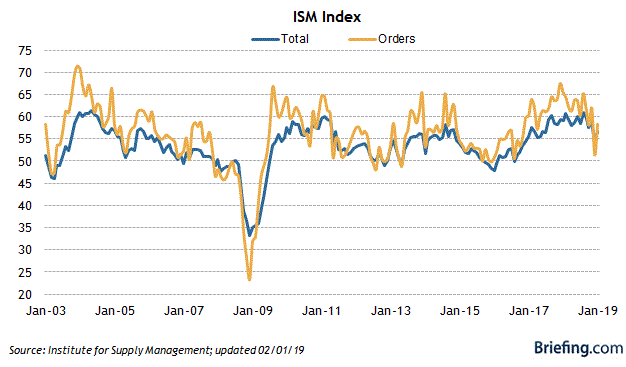
Contrary to my expectations, the most leading new orders component rebounded sharply, up to 58.2. This is closer to its “hot” readings of mid-2018 than to its tepid 51.3 in December.
The second was motor vehicle sales. After housing, this is usually the second aspect of consumer spending to turn. While not great, it was OK:
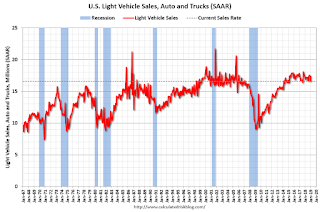
(H/t Calculated Risk).
Motor vehicle sales tend to have long plateaus during expansions, before turning down in the 6 to 12 months before a recession. For me to think such a deterioration has started, I would need to see more than one month of less than 16.5 units sold. In January, 16.6 units were sold on an annualized basis.
No signs of any imminent downturn in this data, even though both have backed off from their best readings.
Tuesday, February 5, 2019
Q4 Senior Loan Officer Survey says ...
- by New Deal democrat
The Senior Loan Officer Survey is one of my list of long leading indicators. The Q4 report came out yesterday.
The news wasn’t good. This post is up at Seeking Alpha.
Meanwhile, since the dates for publication of neither housing permits nor Q4 GDP were announced last week, I am going to go ahead and put up a preliminary forecast for the second half of this year sometime this week.
Monday, February 4, 2019
Leading scenes from the employment report not so positive
- by New Deal democrat
I seem to have been the only person to pick up on the weakness in the underlying leading aspects of last Friday’s jobs report.
While the number of job gains was great, and that average wages for non-managerial workers had their second best showing, at 3.4%, of the entire expansion, just behind last month’s 3.5%, the leading aspects of the report, with one exception, were not so positive.
Let’s start with temporary and manufacturing jobs. Here are two graphs showing their month over month percentage gains over the last 20 years (manufacturing is multiplied *2 for scale purposes):
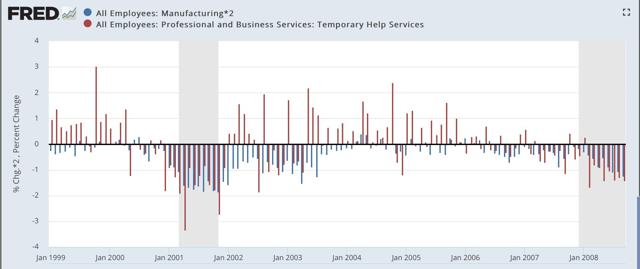
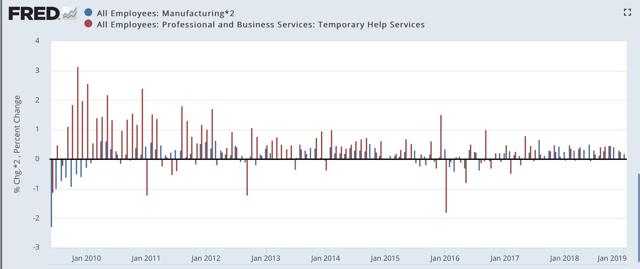
Both of these advance less than 0.2% m/m and ultimately decline m/m before a recession begins.
Now here is a close-up on the last year:
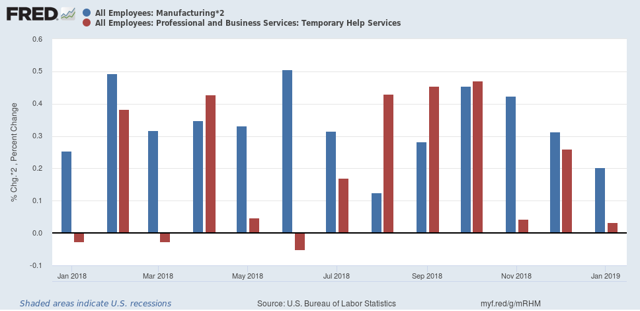
Manufacturing jobs increased just shy of +0.2% as scaled, and temporary jobs less than +0.1% for the second time in three months. Even the three month average for temporary jobs is only +0.1%.
Next, let’s look at the manufacturing work week. This is one of the 10 components of the Index of Leading Indicators, and generally turns before manufacturing jobs do. At 42.0 hours in January, they are 0.4 hours below their recent peak:
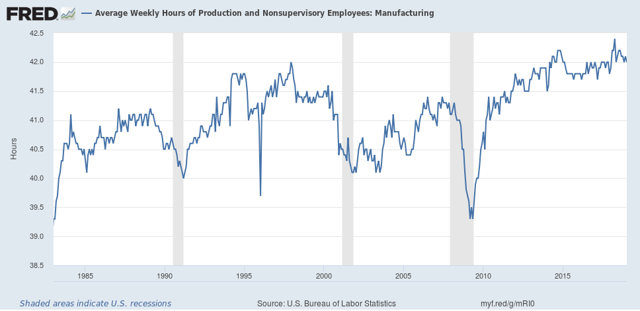
While a turndown of at least -0.5 hours has generally been necessary prior to a recession, the recent decline isn’t just noise and in the last 20 years has usually coincided with a slowdown, such as in 1984, 1994, and 2002.
Next, here is short time unemployment (less than 5 weeks). This is one of the short leading indicators identified by Prof. Geoffrey Moore, and while they are obviously noisy, his research indicated they usually made a bottom before initial jobless claims:
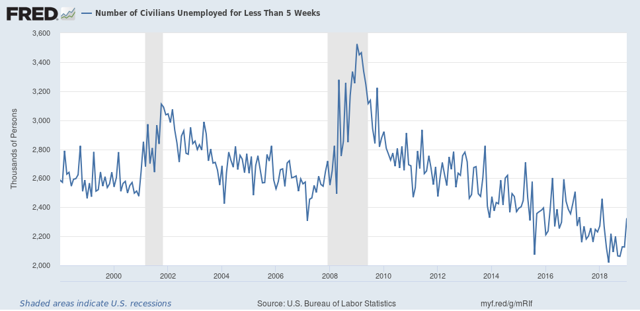

These are clearly within the range of noise, but they have not made a new low for close to a year.
Finally, here are construction jobs for the duration of this expansion. These had one of the 10 best months of the entire 10 year expansion in January:
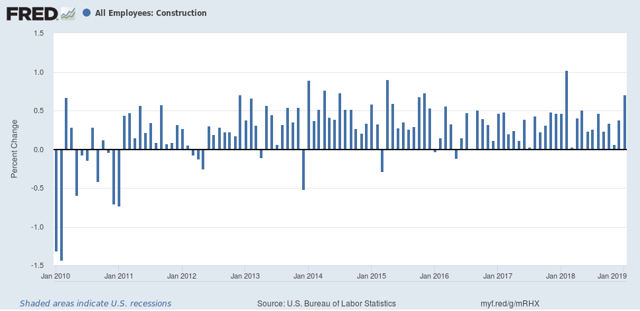

In fact, they stand out in sharp contrast to the weakness in the housing market, so much so that I suspect there will be a substantial downward revision in a month’s time.
In summary, of the five leading indicators in the jobs report, only one — construction jobs — was clearly positive. Two — temporary jobs and manufacturing jobs — while positive, have decelerated significantly and are consistent with a slowdown in the near future. Two — the manufacturing work week and short term unemployment — outright declined. The latter is within the range of noise, but the former is also consistent with a slowdown.
Sunday, February 3, 2019
Reduction in Representation as the remedy for voter suppression
- by New Deal democrat
This is the second take prompted by my reading of David W. Blight‘s biography of Frederick Douglass.
In the “nothing is every really new” department, voter suppression was very much on the mind of Douglass and other radical Republicans during the Civil War and its immediate aftermath. Douglass was fond of saying that blacks would only gain equality once they exercised power through three “boxes: the cartridge box, the jury box, and the ballot box.” In other words, first equality would have to be fought for in the war. Then there would need to be legal equality. And finally, the only way to protect that legal equality would be via the right to vote.
Douglass and others were very clear-minded that the “copperhead” Democrats would continue to suppress freed blacks by denying them access to voting rights, all the while continuing to gain power via counting freed blacks towards representation in the Congress. Sound familiar at all?
While the ultimate step was the passage of the Fifteenth Amendment in 1969-70, the second Section of the Fourteenth Amendment addresses voter suppression directly, and mandates a specific remedy that is well worth renewed consideration today.
Here are the relevant texts of the first and second Sections of the Fourteenth Amendment.
Section One of the Amendment mandates that
“All persons born or naturalized in the United States, and subject to the jurisdiction thereof, are citizens of the United States and of the State wherein they reside.”
Section Two states:
“Representatives shall be apportioned among the several States according to their respective numbers, counting the whole number of persons in each State, excluding Indians not taxed. But when the right to vote at any election ... is denied to any ... citizens of the United States, or in any way abridged, except for participation in rebellion, or other crime, the basis of representation therein shall be reduced in the proportion which the number of such male citizens shall bear to the whole number of male citizens twenty-one years of age in such State.”Further, that Section does not just apply to Federal elections, but also applies to
“the Executive and Judicial officers of a State, or the members of the Legislature thereof.”
And the “any [ ] citizens” to whom Section Two above applied were limited to
“the male inhabitants of such State, being twenty-one years of age.“Of course, since passage of the Fourteenth Amendment, suffrage has also been extended to woman (the Nineteenth Amendment) and to 18 year olds (the Twenty- Amendment). Both of those amendments repeat the “denied or abridged” language of the 14th Amendment above, but without its specific remedial language, instead repeating the general language that Congress could pass legislation to enforce the Amendment.
Thus, in view of the subsequent two Amendments, I see no reason why the specific remedial language of the Fourteenth Amendment should be limited to males age 21 or older. Further, note that nowhere in Section Two of the Fourteenth Amendment does it limit its application to race. Rather, it specifically applies to any “denial or abridgment” to “any citizen” otherwise eligible to vote.
The “abridgment” language is important, because it is broader than a “denial.” It means that the remedy can be invoked even though the right to vote is *not* denied. If voter suppression is a form of “abridgment” of the right to vote — and I certainly believe that it is — then the Section Two remedy is specifically available.
And the remedy is draconian: a reduction in representation for the offending State, in proportion to the “denial or abridgment.”
To take an extreme example of how that might apply, if the partisan gerrymanders of such a state as North Carolina were deemed an “abridgment” of Democrats’ right to vote, then a Court could determine that, since slightly over 50% of North Carolinians cast ballots for Democratic members of Congress, but Democrats were only elected 3 of the state’s 13 Congressional Districts, the GOP representation of North Carolina in Congress must be cut from 10 districts to 3.
Draconian? Absolutely! But that draconian remedy is exactly what is prescribed by both the text and the intent of Section Two of the Fourteenth Amendment.
And unlike the useless flailing that has been the hallmark of litigation since 2010, in which gerrymandered districts have been allowed to continue throughout the entire decade, the mind-concentrating Fourteenth Amendment remedy would be likely to produce immediate results.
To return to the example of North Carolina, it does not take a genius to figure out that, in response to a binding, final order reducing GOP representation in the House from 10 to 3 seats, the legislature would move with lightning-like alacrity to undo the abridgment and arrange new elections.
In fact, so draconian and swift is the Fourteenth Amendment remedy that I doubt it would have to be applied more than once. In short order all states would suddenly scrupulously be in favor of enabling voting by all eligible citizens.
But in closing, to reiterate, this remedy isn’t “pie in the sky.” It isn’t new or novel. It was a remedy thought about and *specifically enacted”in response to the very type of problem that has become endemic in the last decade, and supported by the specific text of the Fourteenth Amendment to the Constitution. Even if the five movement conservatives who form a majority on today’s Supreme Court are unlikely to enforce it, the argument ought to be put into the public discourse now to enable its ultimate adoption.
Frederick Douglass, Andrew Johnson, and the Copperhead GOP
- by New Deal democrat
I am currently reading David W. Blight’s biography of Frederick Douglass, the 19th century orator and champion of black equality. Today I wanted to briefly write on several timely topics inspired by that tome.
Douglass was biracial, or in the parlance of the day, a mulatto. His mother was a young slave named Harriet Bailey. His father was probably Aaron Anthony, the “overseer of overseers” of slaves at the nearby Wye Plantation on the eastern shore of Maryland. He was probably conceived in rape.
His earliest memories included Anthony giving his mother’s sister a vicious whipping for the crime of having a romantic relationship with a young male slave; and Anthony also gently leading him by the hand, patting him on the head, tousling his hair, and calling him “my little Indian boy.”
At about age 12, he was given to the Auld family in Baltimore as a house slave and companion for several of their children. In the first of several portentous mere chances, the wife, Sophia Auld, who had never owned a slave before, included him in her own children’s education, and taught him how to read. Soon he was reading the Bible, and sermonizing at church services among slaves on Sundays.
He escaped to freedom when he was 18, and in another serendipitous episode, was asked to lecture about his experiences at a local abolitionist meeting attended by William Lloyd Garrison. A oratorical star was born.
He was already famous in the 1840s . By the middle of the Civil War he was meeting with Lincoln at the White House, pressing the issues of the abolition of slavery, the enlistment of black soldiers, and the right to vote.
After Lincoln’s assassination, Douglass pressed for activist, interventionist Federal power to protect the rights of freedmen in the South as part of the establishment of a new order.
There he ran into the brick wall of President Andrew Johnson. Johnson was the only Senator from a seceded state (Tennessee) who did not resign, and was a powerful symbol as Lincoln’s 1864 running mate.
The problem was that, aside from opposing secession, and recognizing that the Thirteenth Amendment was fait accompli, Johnson was in favor of “Confederate Reconstruction,” determined to restore the status quo ante, including state’s rights, restoration of land to slaveowners, pardoning of prominent Confederates, providing no help nor rights whatsoever to the freed slaves, and accepting the passage of “black codes” in the South that de facto returned former slaves to servility.
Against this, Douglass led a delegation of 13 men who went to the White House and insisted on a meeting with Johnson that proved deeply contentious.
At the meeting, Johnson claimed that slavery was a de facto conspiracy by masters and slaves against poor whites, and that the abolition of slavery was nothing more than an expedient to suppress the rebellious South. He insisted that states’ rights was a fundamental tenet of the nation, and meant that nothing should be forced on the white majority against their consent. He disdained what he called “abstract ideas of liberty” for blacks that he claimed would result in race war. Johnson subsequently reiterated those views in his strident veto of the 1866 Civil Rights Act, inveighing against the “centralization” of power in the Federal government, and claiming that the extension of civil rights protections for blacks were “fraught with evil” and “made to operate in favor of the colored and against the white race.” Congress overrode that veto.
The contemporaneous term for those who held views like Johnson was “copperheads.” Just last week the almost identical assertions were made on the Senate Floor by Mitch McConnell. His party equally deserves the epithet of the Copperhead GOP.